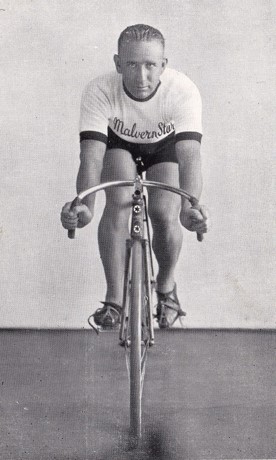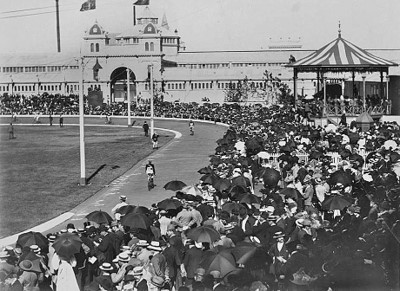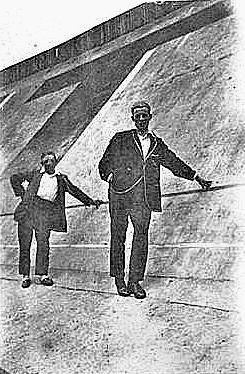The First World War was a global tragedy that affected everyone in some way, with tens of millions of military and civilian deaths.
Sport was totally disrupted with soldiers heading off to the front, daily needs in short supply, and military requirements in demand, all alongside the great air of uncertainty.
An occasional club may have managed half a race to keep the spirits up but for seven years there was no Austral Wheelrace.
It could have meant the end of the great race but there was still some cycling passion burning inside promoters and dedicated riders.
As if a knee-jerk reaction, the calendar year 1923 hosted two Austral Wheelraces and then, how did the year 1927 come up with three promotions? Before looking at those multiples, there is a winning ride in that period by a champion that can't be ignored.
1922: Jack Fitzgerald a winner

Jack Fitzgerald was a "winner" in every sense of the word, including the Austral Wheelrace in 1922 at the Exhibition Oval.
The 1922 Austral Wheelrace was promoted by Jack Campbell at the Exhibition Oval in front of a crowd of 15,000 spectators.
Fitzgerald rode from scratch and only hit the front halfway down the finish straight.
It had been 14 Australs spanning 21 years since a scratch man had won.
Checking his records, he could well be permanently labelled 'winner' for he is credited with winning nine handicaps in succession in Sydney and when overseas, 26 consecutive scratch races. He has won an ANA Wheelrace and 18 out of 19 match races against American Willy Spencer.

The Exhibition Oval was host to eleven Austral Wheelraces resuming there after the war and where Jack Fitzgerald won from scratch in 1922.
Add his various half-mile local and world records and yes, he is a 'winner'. He was also later well known for his 'Coaching by Mail' enterprise.
1923: Two Austral Wheelraces
This came about because two different promoters controlled two different venues. How sanction was obtained for two stagings of the classic only weeks apart is questionable but the riders would not have questioned that.
Exhibition oval on November 24 was promoted by C.F. Lynam and the winner was R.W. Ford riding from 120 yards.
Contracted to race there, American sprinter Willy Spencer appeared to be below form and the crowd let him know it and the officials also discussed the matter with him but no action was taken.

The purpose built Exhibition Oval drew overseas stars and was a successful venue holding eleven stagings of the Austral and another three when converted to a board track later on the same site.
The Melbourne Cricket Ground as a venue was revived in a post-war rally by the Melbourne Bicycle Club. It was on December 8, only two weeks after the Exhibition race and 13 years since the MBC’s last Austral.
It was run over one and a half miles with the winner A.J. Davies (200 yards) from Western Australia.
1927: Three Austral Wheelraces
It raises the question, at least in years gone by, who owned the Austral Wheelrace? The year 1927 had now reasonably recovered from the effects of war, so if a promoter got in first with a date, a track, and a guarantee of prize money, they virtually owned the race by default.
But 1927 was also a year of unrest. Two venues, the Exhibition Oval and the Motordrome were both competing to provide top racing at the same time.
Added to that, there was a breakaway group from the LVW who seemed unable or unwilling to restrict the promotional rivalry.
The riders would hardly be concerned for they now had three opportunities to achieve notoriety and serious competitive prize money.
Exhibition Oval on March 26 was the race date received by early request from a promoter named Aspendale Carnivals supported by Wholesale and Retail Traders.
A newspaper suggestion that two leading amateurs would ride added further to the question of organisational legitimacy.
However, the Austral Wheelrace was run and won by L.C. Stevens from Malvern, otherwise known as 'Bowie' Stevens, riding from 70 yards in the two-mile distance.
There was no scratch rider, with virtual scratch being 35 yards while limit was 350 yards. The total prize money for the carnival was £250.
On April 23 at the Motordrome was the date and venue of the next Austral chosen hastily and almost certainly as a retaliation by Carnivals Limited with well-known promoter Jack Campbell.

The Motordrome had a chequered life, extravagantly built in 1924, its proportions are hard to realise. Banking 18 feet high with three laps to the mile which today represents a 536-metre lap. Primarily for motor cycle racing it also featured Victorian Football League games. Cycling was a minor player supported by Jack Campbell who had no alternate venue.
It was a £500 carnival with £150 as first prize for the Austral won by Cecil Hanneman (NSW) from 160 yards.
December 3 at the Motordrome was the third Austral for the year 1927 and was one of the regular promotions there by Jack Campbell although it was likely an added part of his Austral ownership strategy.
The crowd was estimated at more than 10,000 and they saw C. Manners win the two-mile final riding from 245 yards.
Sir Hubert Opperman rode in the fourth heat but did not qualify. There was a delay during the meeting when glass had to be swept from the track, just one of the results of this unusual venue for track racing, and another when Campbell could not control the changing circumstances leaving 1928 without an Austral.
1929: 'Fatty' Lamb and the Motordrome
There were four Australs in total held at the Motordrome although it was not a cycle track but a purpose-built concrete bowl for motorbikes, three to the mile, and incredibly steep to accommodate the motorbike speeds.
Spectators had to lean out over the top to see the race and that’s when bottles etc. were dropped and several spectators lost their lives doing that.

This Motordrome photo shows the true steepness of the surface. With seven deaths there it was finally dynamited in 1933.
R.W. 'Fatty' Lamb won the last Austral there in 1929 riding from 30 yards.
Lamb was a recognised motor pace rider and on that ideal track he set a new record increasing the one hour distance held by Opperman.
He was the best all-rounder in his era with Warrnambool fastest times to his credit in 1930 and 1932, two national championships in those same years, 35th and lanterne rouge in the 1931 Tour de France, and won the Brisbane six-day in 1932.

“Fatty” Lamb, actually Richard William, was a Malvern Star rider and considered the best all-rounder in his era.
The nickname 'Fatty' came from his schoolyard days and stuck, which he accepted, even signing his postcard that way.
Feature picture: The Exhibition Oval was host to eleven Austral Wheelraces resuming there after the war and where Jack Fitzgerald won from scratch in 1922.
